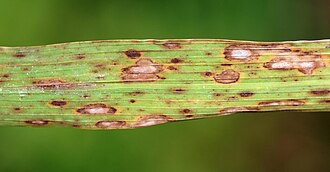Cochliobolus
Cochliobolus is a genus of fungi that is known for its significance in agriculture, particularly because several species within this genus are notable pathogens of cereal crops, causing diseases that lead to significant crop losses worldwide. The genus Cochliobolus is part of the Ascomycota phylum, which is one of the largest and most important groups of fungi, including both beneficial species and those harmful to plants and animals.
Description
Cochliobolus species are characterized by their filamentous growth form, producing mycelium that is essential for nutrient absorption from their host plants. These fungi reproduce both sexually and asexually, with the sexual form producing ascospores contained in an ascus, and the asexual form producing conidia which are dispersed by wind or water to new host plants. The ability to reproduce in two ways contributes to their adaptability and the spread of disease.
Pathogenicity
The pathogenicity of Cochliobolus species is closely linked to their production of toxins and enzymes that degrade plant cell walls, allowing them to invade and colonize host tissues. Diseases caused by Cochliobolus spp. include leaf spot, root rot, and crown rot, among others. One of the most notorious species, Cochliobolus heterostrophus, is the causative agent of Southern corn leaf blight, which had a devastating impact on the United States corn crop in 1970.
Economic Impact
The economic impact of Cochliobolus-induced diseases is significant, particularly in regions where cereal crops such as wheat, corn, and rice are staple foods and major agricultural products. Crop losses due to these diseases can lead to food shortages and economic hardship for farmers. As such, managing Cochliobolus infections is a critical aspect of agricultural practice in many parts of the world.
Management
Management of diseases caused by Cochliobolus spp. involves an integrated approach, including crop rotation, the use of resistant crop varieties, and the application of fungicides. Biological control strategies are also being explored, with some success, as a way to reduce reliance on chemical fungicides. Early detection and accurate identification of the pathogen are crucial for effective disease management.
Research
Research on Cochliobolus is focused on understanding the genetics and biology of these fungi to develop more effective control strategies. This includes studying the mechanisms of pathogenicity, resistance in host plants, and the environmental factors that influence disease outbreaks. Advances in molecular biology and genomics are providing new tools for researchers in this field.
Conclusion
Cochliobolus represents a significant challenge to global food security due to its impact on cereal crops. Continued research and the development of integrated management strategies are essential to mitigate the effects of this pathogen and ensure stable food supplies.
Transform your life with W8MD's budget GLP-1 injections from $125.
W8MD offers a medical weight loss program to lose weight in Philadelphia. Our physician-supervised medical weight loss provides:
- Most insurances accepted or discounted self-pay rates. We will obtain insurance prior authorizations if needed.
- Generic GLP1 weight loss injections from $125 for the starting dose.
- Also offer prescription weight loss medications including Phentermine, Qsymia, Diethylpropion, Contrave etc.
NYC weight loss doctor appointments
Start your NYC weight loss journey today at our NYC medical weight loss and Philadelphia medical weight loss clinics.
- Call 718-946-5500 to lose weight in NYC or for medical weight loss in Philadelphia 215-676-2334.
- Tags:NYC medical weight loss, Philadelphia lose weight Zepbound NYC, Budget GLP1 weight loss injections, Wegovy Philadelphia, Wegovy NYC, Philadelphia medical weight loss, Brookly weight loss and Wegovy NYC
|
WikiMD's Wellness Encyclopedia |
| Let Food Be Thy Medicine Medicine Thy Food - Hippocrates |
Medical Disclaimer: WikiMD is not a substitute for professional medical advice. The information on WikiMD is provided as an information resource only, may be incorrect, outdated or misleading, and is not to be used or relied on for any diagnostic or treatment purposes. Please consult your health care provider before making any healthcare decisions or for guidance about a specific medical condition. WikiMD expressly disclaims responsibility, and shall have no liability, for any damages, loss, injury, or liability whatsoever suffered as a result of your reliance on the information contained in this site. By visiting this site you agree to the foregoing terms and conditions, which may from time to time be changed or supplemented by WikiMD. If you do not agree to the foregoing terms and conditions, you should not enter or use this site. See full disclaimer.
Credits:Most images are courtesy of Wikimedia commons, and templates, categories Wikipedia, licensed under CC BY SA or similar.
Contributors: Prab R. Tumpati, MD

